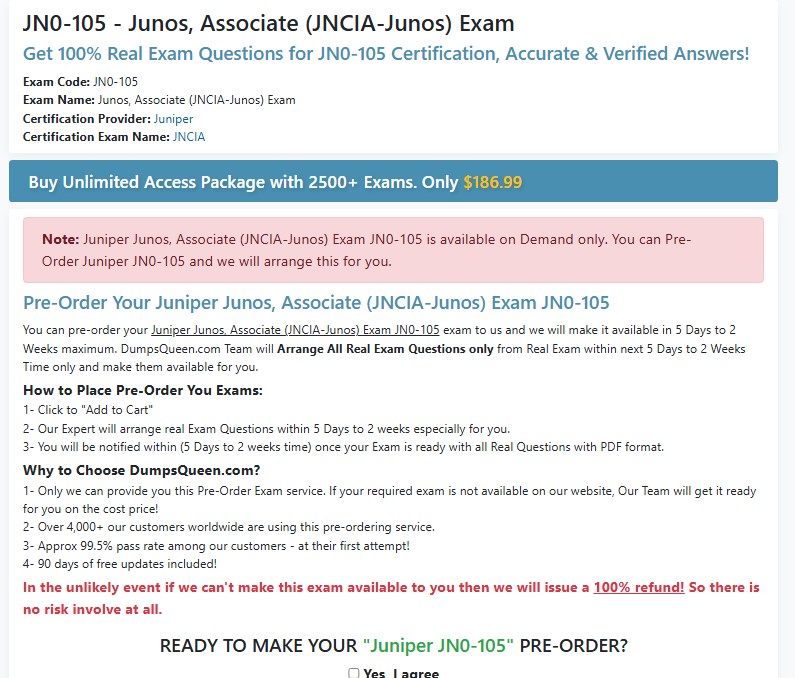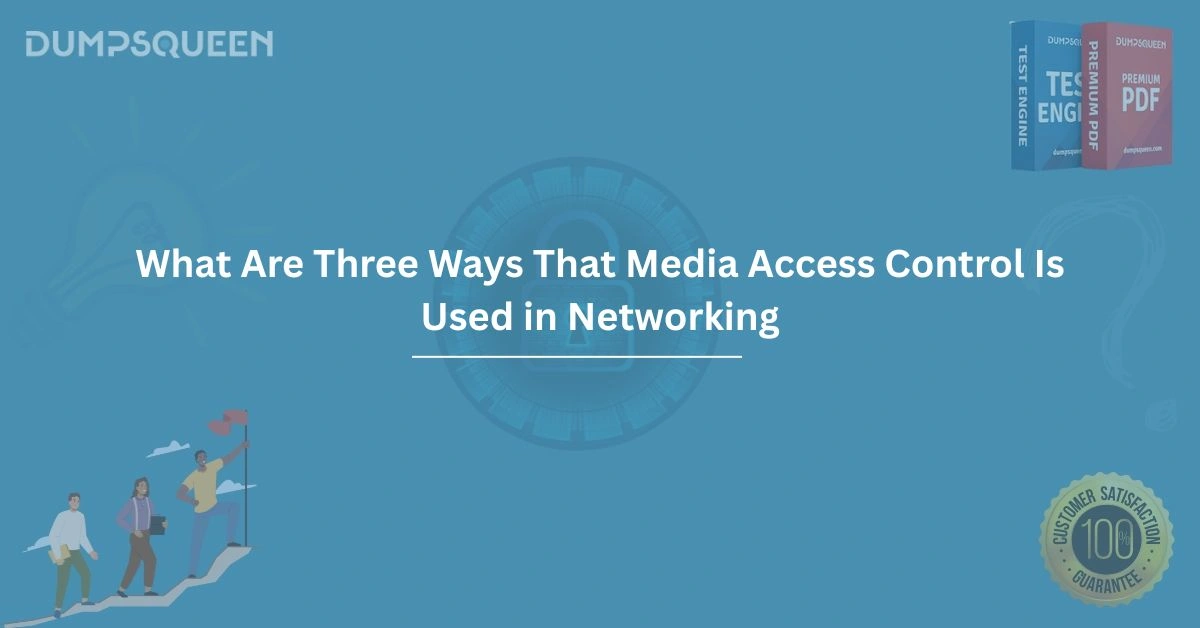Introduction
In the intricate world of computer networking, ensuring efficient and reliable communication between devices is paramount. Media Access Control (MAC) plays a pivotal role in this process by managing how devices access and share a common communication medium, such as a wired or wireless network. MAC is a sublayer of the Data Link Layer in the OSI model, responsible for regulating access to the physical medium, preventing data collisions, and ensuring smooth data transmission. For professionals and students preparing for networking certifications, understanding the applications of MAC is essential. At DumpsQueen, we provide comprehensive resources to help you master networking concepts like MAC and excel in your certification exams. This blog explores three key ways Media Access Control is used in networking, delving into its mechanisms and significance in modern network environments.
Collision Avoidance in Ethernet Networks
One of the primary applications of Media Access Control is in collision avoidance, particularly in Ethernet networks that use shared media. In traditional Ethernet networks, multiple devices are connected to a single communication medium, such as a coaxial cable or a hub-based network. When two or more devices attempt to transmit data simultaneously, a collision occurs, resulting in data corruption and the need for retransmission. MAC addresses this challenge through a mechanism known as Carrier Sense Multiple Access with Collision Detection (CSMA/CD).
CSMA/CD is a protocol that governs how devices access the shared medium. Before transmitting data, a device listens to the network to determine if the medium is idle—a process known as "carrier sensing." If the medium is free, the device begins transmission. However, if another device starts transmitting at the same time, a collision may occur. The MAC sublayer detects this collision by monitoring the signal on the medium. Upon detecting a collision, the transmitting devices stop, send a jam signal to inform other devices of the collision, and wait for a random period before attempting to retransmit. This random backoff period reduces the likelihood of repeated collisions.
In modern Ethernet networks, the widespread use of switches has reduced the reliance on CSMA/CD, as switches create dedicated communication paths between devices, minimizing collisions. However, CSMA/CD remains relevant in certain scenarios, such as legacy networks or specific industrial Ethernet setups. Understanding collision avoidance is critical for networking professionals, and DumpsQueen offers expertly curated study materials to help you grasp these concepts thoroughly.
Access Control in Wireless Networks
Media Access Control is equally vital in wireless networks, where devices share a radio frequency spectrum to communicate. Unlike wired Ethernet, wireless networks face unique challenges, such as signal interference, hidden node problems, and the inability to detect collisions during transmission. To address these issues, wireless networks employ a MAC protocol known as Carrier Sense Multiple Access with Collision Avoidance (CSMA/CA).
In CSMA/CA, devices listen to the wireless channel to ensure it is idle before transmitting data. To further reduce the risk of collisions, devices use a handshake mechanism involving Request to Send (RTS) and Clear to Send (CTS) messages. When a device wishes to transmit, it sends an RTS frame to the intended recipient. If the recipient is ready, it responds with a CTS frame, informing other devices in the vicinity to refrain from transmitting for a specified duration. This process reserves the channel for the transmitting device, minimizing the chance of collisions.
CSMA/CA also incorporates mechanisms like the Network Allocation Vector (NAV), which tracks the duration for which the channel will be busy, and random backoff intervals to manage access when multiple devices attempt to transmit simultaneously. These techniques are fundamental to the operation of Wi-Fi networks based on the IEEE 802.11 standard. For instance, when you connect to a Wi-Fi hotspot at a café, the MAC sublayer ensures that your device communicates efficiently with the access point without interfering with other users’ transmissions.
The complexity of wireless MAC protocols underscores the importance of thorough preparation for networking certifications. DumpsQueen provides detailed guides and practice questions to help you master wireless networking concepts, ensuring you’re well-equipped for exams like CompTIA Network+ or Cisco CCNA.
Token Passing in Token-Based Networks
Another significant application of Media Access Control is in token-based networks, such as Token Ring and Token Bus, where access to the communication medium is controlled through a token-passing mechanism. Unlike CSMA/CD or CSMA/CA, which rely on contention-based access, token passing is a deterministic method that eliminates collisions entirely, making it suitable for networks requiring predictable and reliable performance.
In a Token Ring network, devices are connected in a logical ring topology. A special control frame, known as a token, circulates around the ring. Only the device possessing the token is permitted to transmit data. When a device receives the token and has data to send, it attaches the data to the token and sends it to the next device in the ring. The data circulates until it reaches the intended recipient, who acknowledges receipt. Once the transmission is complete, the device releases the token, passing it to the next device in the ring. This orderly process ensures that each device gets a fair opportunity to transmit without competing for access.
Token Bus networks operate similarly, but devices are connected in a bus topology, and the token is passed in a predefined logical sequence. These networks were historically used in industrial automation and manufacturing environments, where consistent and predictable data delivery was critical. For example, in a factory setting, a Token Bus network might be used to coordinate communication between sensors, controllers, and actuators, ensuring precise timing and avoiding data loss.
Although token-based networks are less common today due to the dominance of Ethernet and Wi-Fi, their principles remain relevant in certain niche applications and are often covered in networking certification exams. DumpsQueen comprehensive study resources include detailed explanations of token-passing mechanisms, helping you build a solid foundation in MAC protocols.
The Role of MAC Addresses in Networking
Beyond specific access control mechanisms, Media Access Control is integral to the identification and addressing of devices in a network. Every network interface card (NIC) is assigned a unique MAC address, a 48-bit identifier typically represented as six pairs of hexadecimal digits (e.g., 00:1A:2B:3C:4D:5E). The MAC address serves as a physical address for devices at the Data Link Layer, enabling accurate delivery of data frames within a local network.
When a device sends data, the MAC sublayer encapsulates the data into a frame, including the source and destination MAC addresses. Switches and bridges use these addresses to forward frames to the correct recipient within the same network. For instance, when you stream a video on your laptop, the MAC sublayer ensures that the data packets are correctly routed from the router to your device’s NIC, avoiding misdelivery to other devices on the network.
MAC addresses are also critical in network security. Many networks implement MAC address filtering, where only devices with authorized MAC addresses are allowed to connect. While this method has limitations, it adds an additional layer of access control. Understanding the role of MAC addresses is essential for network administrators and certification candidates. DumpsQueen expertly designed practice exams cover MAC addressing in depth, helping you prepare for real-world scenarios and certification challenges.
Practical Implications and Modern Relevance
The applications of Media Access Control extend beyond theoretical concepts, influencing the design and operation of modern networks. In enterprise environments, MAC protocols ensure efficient communication across diverse devices, from servers and workstations to IoT devices and mobile phones. The principles of collision avoidance, access control, and token passing underpin the performance of both wired and wireless networks, enabling seamless connectivity in homes, offices, and public spaces.
In the context of emerging technologies, MAC protocols are evolving to meet new demands. For example, in 5G networks, advanced MAC mechanisms manage access to the radio spectrum, supporting ultra-low latency and massive device connectivity. Similarly, in IoT networks, lightweight MAC protocols optimize energy efficiency for battery-powered devices. These advancements highlight the ongoing relevance of MAC in networking and the need for professionals to stay updated on its applications.
For those pursuing networking certifications, mastering MAC concepts is a stepping stone to success. DumpsQueen offers a wealth of resources, including study guides, practice tests, and expert insights, to help you navigate the complexities of networking protocols and achieve your certification goals.
Conclusion
Media Access Control is a cornerstone of networking, enabling devices to communicate efficiently and reliably across shared media. Its applications in collision avoidance, access control in wireless networks, and token passing demonstrate its versatility and importance in both legacy and modern network environments. Additionally, the use of MAC addresses ensures accurate data delivery and supports network security measures. As networking technologies continue to evolve, the principles of MAC remain fundamental, making it a critical topic for professionals and certification candidates alike.
At DumpsQueen, we are committed to empowering you with the knowledge and resources needed to excel in networking certifications. Our offers expertly crafted study materials, practice exams, and insights to help you master concepts like Media Access Control and achieve your career goals. Visit our website today to explore our offerings and take the next step in your networking journey.
Free Sample Questions
Question 1: What is the primary purpose of the CSMA/CD protocol in Ethernet networks?
A) To assign MAC addresses to devices
B) To prevent collisions on a shared medium
C) To encrypt data during transmission
D) To prioritize traffic based on QoS settings
Answer: B) To prevent collisions on a shared medium
Question 2: In a Wi-Fi network, what mechanism does CSMA/CA use to reserve the wireless channel?
A) Token passing
B) RTS/CTS handshake
C) MAC address filtering
D) Carrier sensing only
Answer: B) RTS/CTS handshake
Question 3: Which networking topology is most commonly associated with the Token Ring protocol?
A) Star
B) Bus
C) Ring
D) Mesh
Answer: C) Ring
Question 4: What is the role of a MAC address in a network?
A) To identify devices at the Network Layer
B) To provide a unique identifier for devices at the Data Link Layer
C) To establish a connection to the internet
D) To compress data for faster transmission
Answer: B) To provide a unique identifier for devices at the Data Link Layer



